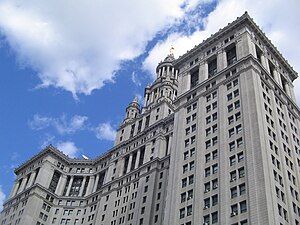
Image via Wikipedia
There’s no doubt that New York City is weathering this tough economy far better than the rest of the country. Since the national recession began, the U.S. has lost 5.6 percent of private-sector jobs. New York City, on the other hand, has lost only .3 percent. And since October 2009, the nation has gained back one out of every four jobs that were lost. Meanwhile, New York City has gained back all of its lost jobs – and added even more.
Our city’s resilience and recovery didn’t happen by accident. It happened because of the investments we continue to make to diversify our economy, spur innovation, and establish the conditions for long-term growth. And last week we saw two great examples of that.
Let’s start with our work to help entrepreneurs, who’ve always provided the heartbeat of our city’s economy. For many of them, the initial costs of office space and modern equipment can keep their businesses from getting off the ground. That’s why we’ve opened low-cost workspaces for entrepreneurs in growing industries like technology, fashion and media.
Earlier this month, I visited one of these “business incubators,” as we call them. It’s located in Long Island City and it focuses on startups in the culinary industry. One of the biggest challenges for many budding chefs is getting access to a fully licensed commercial kitchen. Our culinary incubator has four of them, and 120 entrepreneurs are currently taking advantage of the opportunity. Our hope for all of the entrepreneurs is that they’ll eventually open their own shops, creating jobs and injecting new energy into our economy.
Altogether, we’ve established nine different incubators across the city. Combined, they provide more than 125,000 square feet of affordable real estate to more than 500 growing businesses, and support some 800 jobs. And in another measure of their success, tenants in our incubators have received more than $39 million in venture capital funding.
Recently, we saw another example of our work to encourage job growth. We selected a developer to transform the bottom floors of the Brooklyn Municipal Building into a major retail destination. Those floors are currently occupied by the city’s Department of Finance. But as part of our ambitious effort to use the city’s real estate more efficiently, we’re relocating the Finance Department to other parts of the Municipal Building, freeing up space for new shops and a full-scale restaurant.
This move will give another shot in the arm to Downtown Brooklyn, which has experienced tremendous growth. On the back of $200 million in public infrastructure improvements, we’ve been able to attract $3.4 billion in new private investment to the Downtown area over the past five years. That translates into thousands of new jobs – and the new retail in the Brooklyn Municipal Building will create hundreds more.
Make no mistake: in this tough economy, creating jobs is our No. 1 job. Across our city we’re pursuing numerous projects that are putting thousands more New Yorkers to work, giving our economy a boost when it needs it and building our city’s future for generations to come.




